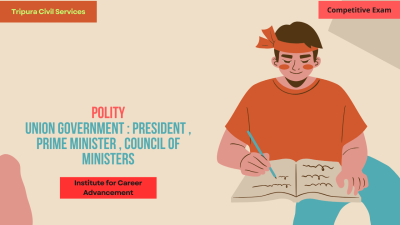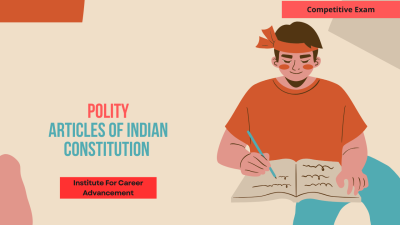Union Government : President , Prime Minister , Council of Ministers
The Union Government of India consists of three key elements: the President, the Prime Minister, and the Council of Ministers. President: The President of India is the ceremonial head of state and the supreme commander of the armed forces. The President represents the unity and integrity of the country but acts mainly on the advice of the Prime Minister and the Council of Ministers. Prime Minister: The Prime Minister is the head of government and exercises executive powers. The Prime Minister leads the Council of Ministers, represents India both domestically and internationally, and plays a central role in formulating and implementing policies. Council of Ministers: The Council of Ministers is a body of appointed officials, headed by the Prime Minister, that assists in the administration of the government. It consists of Cabinet Ministers, Ministers of State, and Deputy Ministers, each handling specific portfolios. They collectively help in decision-making and policy implementation. This structure defines the functioning of the executive branch of the Union Government in India. ভারতের কেন্দ্রীয় সরকার তিনটি মূল উপাদান নিয়ে গঠিতঃ রাষ্ট্রপতি, প্রধানমন্ত্রী এবং মন্ত্রী পরিষদ। রাষ্ট্রপতিঃ ভারতের রাষ্ট্রপতি হলেন আনুষ্ঠানিক রাষ্ট্রপ্রধান এবং সশস্ত্র বাহিনীর সর্বোচ্চ সেনাপতি। রাষ্ট্রপতি দেশের ঐক্য ও অখণ্ডতার প্রতিনিধিত্ব করেন কিন্তু প্রধানত প্রধানমন্ত্রী ও মন্ত্রিপরিষদের পরামর্শে কাজ করেন। প্রধানমন্ত্রীঃ প্রধানমন্ত্রী হলেন সরকারের প্রধান এবং নির্বাহী ক্ষমতা প্রয়োগ করেন। প্রধানমন্ত্রী মন্ত্রী পরিষদের নেতৃত্ব দেন, দেশীয় ও আন্তর্জাতিক উভয় ক্ষেত্রেই ভারতের প্রতিনিধিত্ব করেন এবং নীতি প্রণয়ন ও বাস্তবায়নে কেন্দ্রীয় ভূমিকা পালন করেন। মন্ত্রী পরিষদঃ মন্ত্রী পরিষদ হল প্রধানমন্ত্রীর নেতৃত্বে নিযুক্ত কর্মকর্তাদের একটি সংস্থা, যা সরকারের প্রশাসনে সহায়তা করে। এটি ক্যাবিনেট মন্ত্রী, প্রতিমন্ত্রী এবং উপমন্ত্রীদের নিয়ে গঠিত, প্রত্যেকে নির্দিষ্ট পোর্টফোলিওগুলি পরিচালনা করে। তারা সম্মিলিতভাবে সিদ্ধান্ত গ্রহণ এবং নীতি বাস্তবায়নে সহায়তা করে। এই কাঠামোটি ভারতে কেন্দ্রীয় সরকারের কার্যনির্বাহী শাখার কার্যকারিতা নির্ধারণ করে।
English
Last updated
Sat, 11-Jan-2025



















